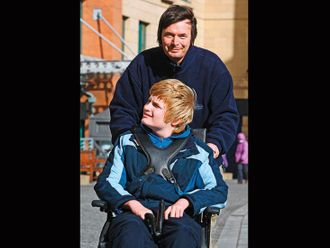
Why do movies make us cry? Why do some books become bestsellers? Why does advice from some friends make perfect sense?
The answer, my friend, is … neural coupling.
It’s when the listener’s brain “fires” neurons in the same patterns as the speaker’s brain – the secret to great storytelling and every great ballad ever written. By sharing a narrative, we create a shared common experience that can even induce empathy. “The listener’s brain activity mirrors that of the storyteller’s brain,” explains Ovgu Ozturkeri, a neurologist at the Dubai-based German Neuroscience Center. “The greater the neural coupling, the greater the listener’s understanding is. This means that when we hear a story, our brains process it as if we are experiencing it ourselves. We feel the emotions, imagine the scenes, and empathise with the characters,” she says.
How neural coupling happens in the brain

Neural coupling is made possible by the activation of several brain regions that are involved in different aspects of storytelling, as explained by Ozturkeri.
● The temporoparietal junction: The precuneus, and the inferior parietal lobule, which are associated with empathy and social cognition. These regions help us to take the perspective of others, to infer their mental states, and to share their feelings.
● The motor and sensory cortices, which are associated with action and perception. These regions help us to simulate the actions and sensations that we hear in the story, such as running, jumping, or touching.
●The frontal cortex, which is associated with executive functions and prediction. This region helps us to anticipate what will happen next in the story, and to evaluate its outcome.
“These brain regions work together to create a shared contextual model of the situation between the storyteller and the listener. This model allows them to communicate effectively and efficiently, as well as to create a sense of immersion and engagement,” she says.
In an article A Case for Narrative Intelligence from the book Rewriting Leadership With Narrative Intelligence, by American researcher Greg Morgan, he cites neuroscientists expounding further on the idea of neural coupling, by sharing the results of an experiments. When people viewed the same footage or listen to a story being told, brain imagery confirmed that neural coupling occurred by showing the participants brain mirroring each other’s. When people hear the paraphrased version of a film or a story, their brain activity is similar despite the fact that one person is producing the language and the other is understanding it.
The research also showed the influence a speaker can have on a listener. The research also proved the influence a speaker can have on the thinking of listeners. There is a slight delay in the brain activity, matching the speakers, which suggests a pivotal connection between the speaker’s words and the responses in the listener’s brains.
How neural coupling generates empathy

He wondered why the film Million Dollar Baby made him cry.
This emotion is generated due to the mirror activity in the brain, during neural coupling. According to current neuro-scientific research, this emotion isn’t a vicarious experience; people do feel a genuine connection, according to Paul J. Zack, a neuroscientist, as cited by Greg Morgan in A Case for Narrative Intelligence. An engaging, compelling narrative can create a literal and neural connection between two people; it moves beyond the metaphorical context.
According to George Lakoff, an American cognitive linguist quoted in the article, the mirror neuron research proves that we are born for empathy. This plays a crucial role in how our brain processes experiences. There’s a deep reciprocity between the emotions and the cognitive abilities in the brain function, which results in subsequent action. The need to take action to help others seems more likely due to empathy. The emotions are generated from feeling the knowledge of someone else’s pain pushes us to take action, than simply just having the knowledge of it.
In 2015, Zak, in his research paper Why Inspiring Stories Make Us React: The Neuroscience of Narrative conducted an experiment to show how a well-crafted story could generate high levels of empathy in people, which could trigger changes in their thinking attitudes, and action. This thought struck him after he sobbed when watching the film, A Million Dollar Baby. Perplexed, he decided to conduct a battery of tests in his lab, and concluded that engaging narratives lead to the release of the neuro-chemical oxytocin in the brain.
The experiment:
Zak and his colleague edited a series of clips, obtained from a children’s research hospital. In one clip, a father spoke to the camera, while his two-year-old son Ben, suffering from cancer, plays in the background. The story portrayed how the emotional father was struggling to connect and enjoy the time remaining with his son. In another video, the same father and son were spending a day at the zoo. This video did not mention cancer or death, and did not have any of the emotional moments recorded in the previous video.
In the first study, they took the blood before and after participants watched one of the two versions. They found that the narrative with the dramatic arc showed an increase in cortisol and oxytocin. This change in oxytocin level pointed towards the feelings of empathy towards the child and his father. Participants who had high levels of empathy, even offered money to the stranger, who was a part of the experiment. However, on the other hand, the participants did not report empathy for the story about the father and the son at the zoo.
The power of narrative transportation

As explained by Zak, oxytocin is a neural hormone in mammals, birds and reptiles, and is largely responsible for attachment behaviour between people. It reduces stress, and helps people to foster nurturing relationships with each other.
Neuroscientists have now established oxytocin as the neurochemical responsible for empathy and narrative transportation. These “rich” narratives, as explained by psychologists David Comer Kidd and Emmanuel Castano in their 2013 work, Theory of Mind, have the ability to transport viewers, readers, or listeners, so that the experience of the narrative simulates a full, real-life version of the experience.
As a result, when our brain finds the pattern-recognition it seeks, it also releases dopamine, which stimulates the brain’s reward and pleasure centers. Kidd and Castano also argued that people who read literary fiction, were better equipped to read other people’s emotions and have empathy. When they were “transported”, their empathy increased. People who don’t get transported in such a manner, have a reduced sense of empathy.
“Neural coupling is a fascinating phenomenon that reveals how our brains are wired for stories. Stories have the power to connect us with others, to shape our thoughts and feelings, and to enrich our lives. By understanding how neural coupling works, we can become better storytellers and listeners,” says Ovgu Ozturkeri, Dubai-based neurologist.

Neural coupling is a fascinating phenomenon that reveals how our brains are wired for stories. Stories have the power to connect us with others, to shape our thoughts and feelings, and to enrich our lives. By understanding how neural coupling works, we can become better storytellers and listeners
“It has many benefits for both the storyteller and the listener,” she says. “For the storyteller, neural coupling can help to convey a message more effectively, to persuade or influence others, and to build trust,” she explains.
As intelligence researcher Ken Richardson in 2017 had theorised, neural coupling constrains and shapes the actions of each individual in a social network, which leads to complex joined behaviours that shouldn’t be just studied in isolation. Neural coupling ultimately shapes cultures. “Attributes of culture aren’t just passed to each other like items on a grocery list,” he had said. “It is woven into a unique tapestry of understanding, a worldview, which emerges from interactions.”












